The Bonnet Carré Spillway will finally close this week after two separate openings totaling an unprecedented 120 days. The spillway was built to protect New Orleans and surrounding parishes from Mississippi River flooding as part of the Mississippi River and Tributaries system designed after the Great Flood of 1927.
This comes on the heels of another first when, earlier this month, Hurricane Barry was the first tropical storm to make landfall while the Mississippi River was at flood stage. This one-two punch — tropical storm combined with high river — was previously only a nightmare scenario with the potential to send storm surge upriver, overtopping levees, inundating the city and surrounding region, and shutting down globally significant commerce.
Mercifully, that scenario did not occur—Barry shifted westward, river levels never reached projected heights and rainfall diminished. However, the river remains dangerously high into the thick of hurricane season. During Hurricane Katrina, storm surge in the river increased the water level by 13 feet, but the river was so low that it wasn’t a threat. The combination hurricane-river flood scenario could play out again – and next time we may not be so lucky.
Louisiana floods in three ways: 1.) From water flowing down the Mississippi and other rivers; 2.) From storm surge and rising seas from the Gulf of Mexico; 3.) From rainfall, now increasing in intensity and overwhelming existing drainage systems. With Barry, for the first time ever, we faced all three threats at once, and climate change will only compound them.
Going forward, we must learn to live with water. On the Mississippi River specifically, the current management system no longer meets the needs of the future. Here are four strategies to help us get there:
1. Give the river more room to flow: This year, upper Mississippi River flooding swamped communities and devastated farms from the Midwest to the Mississippi Delta. Restoring the river’s natural floodplains and providing room for the river to expand as it rises will reduce flood levels throughout the watershed. It will also limit openings of the Bonnet Carré Spillway and downriver flooding that negatively impacted Louisiana’s fisheries due to the prodigious volume of water flowing into the state’s estuaries.
2. Reduce runoff into the river: Increasing the capacity of communities and farms to retain and slow water before it reaches the river will reduce both flooding and nutrient losses that harm water quality. We can do this by catching water where it falls, increasing soil permeability and water filtration, increasing permeable surfaces and catch basins, and by planting vegetation and restoring wetlands adjacent to the river. By reducing runoff throughout the Mississippi River drainage basin, we not only reduce flooding, but can also reduce nutrients that lead to the Gulf’s dead zone and algal blooms.
3. Use river sediment and nutrients to nourish and build wetlands: When the Lower Mississippi River system was designed over 100 years ago, lead engineers acknowledged that it would negatively impact Louisiana’s coast. The very levees that keep the Mississippi River out of people’s homes also keep the river’s sediment out of its wetlands – a major factor in the state’s ongoing land-loss crisis. Mississippi River management must balance navigation, flood protection and restoration to confront the challenges of our changing climate and landscape head-on Share on X
In order to capture the nearly 100 million tons of sediment flowing past Louisiana annually, the state is advancing large-scale coastal restoration projects called sediment diversions that will be constructed into the levees on both sides of the river south of New Orleans. These projects will deliver sediment to wetlands and help build and sustain tens of thousands of acres of land over time. They will also deliver nutrients to wetlands, which can filter these nutrients and remove them from the Gulf and open bodies of water to reduce the dead zone and algal blooms. A future without these projects, particularly one with rising seas and more intense storms, would be truly dire for Louisiana.
4. Advance bold, forward-looking solutions to meet the serious challenges of the future: We also need to think differently about how to confront this new set of challenges. Several years back, EDF did just that by spearheading Changing Course, a design competition to create a sustainable future for the Lower Mississippi River. The winning teams developed visions that substantially reduced the river’s flood stage at New Orleans and the need to use the Bonnet Carré Spillway, while creating a sustainable and resilient delta for future generations.
We can no longer control the river, but must work with her to chart a course for the future. As Congress looks to the Corps of Engineers to repair the levee system from flood damages, they should also provide funding to begin implementing long-studied solutions throughout the basin before the next combined river flood and hurricane. Going forward, Mississippi River management must balance navigation, flood protection and restoration to confront the challenges of our changing climate and landscape head-on.












One Comment
what about asking the country to reduce carbon emissions and hopefully we can lower the temps out in the gulf to reduce tropical formation?